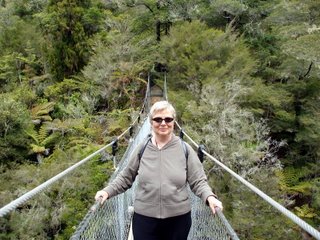

 Even though we're back home now I think I'll keep going and write up the rest of our New Zealand trip, it would be a shame to leave it uncompleted. So, taking up the story at Queenstown, I'll carry on.
Even though we're back home now I think I'll keep going and write up the rest of our New Zealand trip, it would be a shame to leave it uncompleted. So, taking up the story at Queenstown, I'll carry on.From Queenstown we drove down to Te Anau on the edge of Fiordland, which was to be our base for a trip to Milford Sound. Everything that everyone says about Milford Sound is true. Out little boat sailed from dock at Milford Sound and out into the Tasman passing sheer cliffs diving straight into the sea, waterfalls and wildlife. We were lucky with the weather too, it was mainly overcast, but dry. The pictures will have to tell the story, I'm afraid.
So, (1) snow-capped mountains with waterfalls, (2) and (3) close-in to one of the waterfalls. The captain of the boat actually put the bowsprit under some of these falls.












